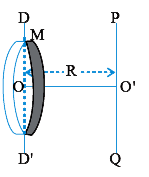A particle of mass 1 kg is kept at (1m,1m,1m). The moment of inertia of this particle about Z-axis would be
1kg-m2
2kg-m2
3kg-m2
None of these
The correct Answer is:B
To find the moment of inertia of a particle about the Z-axis, we can follow these steps:
Step 1: Understand the coordinates of the particle
The particle has a mass m=1kg and is located at the coordinates (1m,1m,1m).
Step 2: Identify the formula for moment of inertia about the Z-axis
The moment of inertia I about the Z-axis for a point mass is given by the formula:
I=m⋅r2
where r is the perpendicular distance from the Z-axis to the point mass.
Step 3: Calculate the distance r from the Z-axis
For a point located at coordinates (x,y,z), the distance r from the Z-axis (which is defined by x=0 and y=0) can be calculated using the formula:
r=√x2+y2
In this case, the coordinates are (1,1,1):
r=√(1)2+(1)2=√1+1=√2m
Step 4: Substitute the values into the moment of inertia formula
Now, substituting the values of m and r into the moment of inertia formula:
I=m⋅r2=1kg⋅(√2)2
Calculating r2:
r2=(√2)2=2
Thus,
I=1kg⋅2=2kg⋅m2
Step 5: Conclusion
The moment of inertia of the particle about the Z-axis is:
I=2kg⋅m2
The particle has a mass m=1kg and is located at the coordinates (1m,1m,1m).
The moment of inertia I about the Z-axis for a point mass is given by the formula:
I=m⋅r2
where r is the perpendicular distance from the Z-axis to the point mass.
For a point located at coordinates (x,y,z), the distance r from the Z-axis (which is defined by x=0 and y=0) can be calculated using the formula:
r=√x2+y2
In this case, the coordinates are (1,1,1):
r=√(1)2+(1)2=√1+1=√2m
Now, substituting the values of m and r into the moment of inertia formula:
I=m⋅r2=1kg⋅(√2)2
Calculating r2:
r2=(√2)2=2
Thus,
I=1kg⋅2=2kg⋅m2
The moment of inertia of the particle about the Z-axis is:
I=2kg⋅m2
Topper's Solved these Questions
- ROTATIONBOOK - DC PANDEYCHAPTER - ROTATIONEXERCISE - Check point 9.2
20 Videos
- ROTATIONBOOK - DC PANDEYCHAPTER - ROTATIONEXERCISE - Check point 9.3
15 Videos
- ROTATIONBOOK - DC PANDEYCHAPTER - ROTATIONEXERCISE - (C) Chapter Exercises
39 Videos
- RAY OPTICSBOOK - DC PANDEYCHAPTER - RAY OPTICSEXERCISE - Integer type q.
15 Videos
- ROTATIONAL MECHANICSBOOK - DC PANDEYCHAPTER - ROTATIONAL MECHANICSEXERCISE - Subjective Questions
2 Videos
Similar Questions
Knowledge Check
Two particles of masses 2 kg and 3 kg are separated by 5 m. Then moment of inertia of the system about an axis passing through the centre of mass of the system and perpendicular to the line joining them is
A10kgm2B20kgm2C30kgm2D40kgm2Two partcles of masses 1 kg and 2 kg are placed at a distance of 3 m. Moment of inertia of the particles about an axis passing through their centre of mass and perpedicular to the line joining them is (in kg−m2)
A6B9C8D12In an arrangement four particles, each of mass 2 gram are situated at the coordinate points (3, 2, 0), (1, –1, 0), (0, 0, 0) and (–1, 1, 0). The moment of inertia of this arrangement about the Z-axis will be
A8 unitsB16 unitsC43 unitsD34 units
If the radius of gyration of a solid disc of mass 10 kg about an axis is 0.40 m, then the moment of inertia of the disc about that axis is
View SolutionFour point masses, each of value m, are placed at the corners of a square ABCD of side 1. The moment of inertia of this system about an axis through A and parallel to BD is
View SolutionA stone of mass 4kg is whirled in a horizontal circle of radius 1m and makes 2 rev/sec. The moment of inertia of the stone about the axis of rotation is
View SolutionMass centers of a system of three particles of masses 1,2,3kg is at the point (1m,2m,3m) and mass center of another group of two partices of masses 2kg and 3kg is at point (−1m,3m,−2m). Where a 5kg particle should be placed, so that mass center of the system of all these six particles shifts to mass center of the first system?
View SolutionThree point masses m1,m2 and m3 are located at the vertices of an equilateral triangle of side α. What is the moment of inertia of the system about an axis along the altitude of the triangle passing through m1?
View Solution

